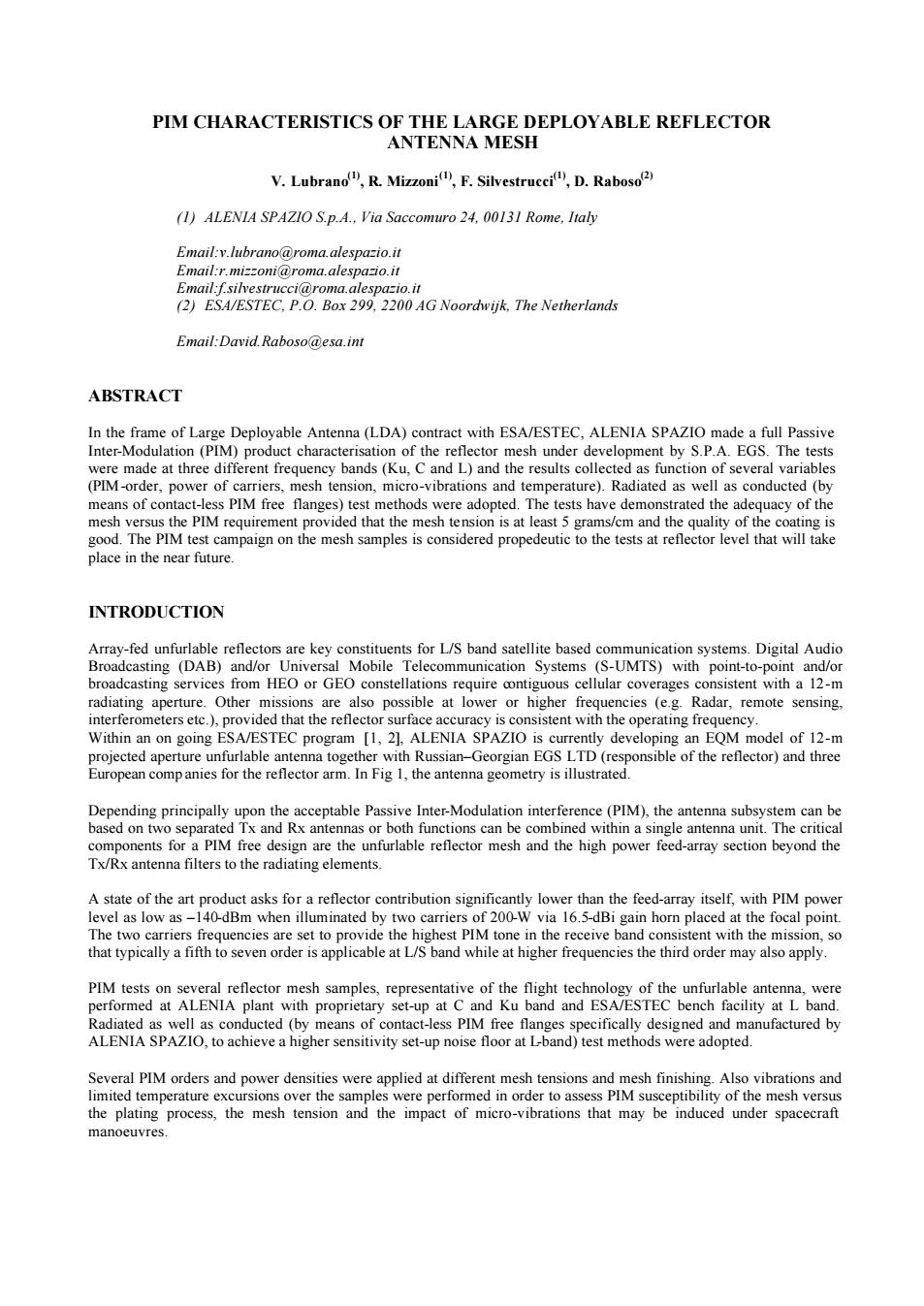正在加载图片...

PIM CHARACTERISTICS OF THE LARGE DEPLOYABLE REFLECTOR ANTENNA MESH V.Lubrano R.Mizzoni F.Silvestrucci)D.Raboso (1)ALENIA SPAZIO S.p.-A.Via Saccomuro 24.00131 Rome,ltaby mil-hbrnme AG Noordwijk.The Netherlands Email-David.Raboso@esa.int ABSTRACT In the frame of Large Deployable Antenna(LDA)contract with ESA/ESTEC,ALENIA SPAZIO made a full Passive bad (d1)and e eo powe s.mesh ten sion,mic perature).Radiated asw mesh versus oee INTRODUCTION Digital audi int a nd/o erferometers etc. tht the re odel of 12. enna togethe vith russian Georgian EGS LTD (responsible of the refector)ndr sforthe reflector m In Fi 1.thentn gometr Depending principally upn the acceptable(PIM),the antena subs yste m can b Tx/Rx antenna filters to the radiating elements. A state of the art product asks for a reflector contribution signific tly lower than the feed-array itself,with PIM powe that typically a fifth to seven order is applicable at L/S band while at higher frequencies the third order may also apply d at NIA pla Ku band and Aohe n obe o nta Several PIM orders and power densities were applied at different mesh tensions and mesh finishin Also vibrations and space PIM CHARACTERISTICS OF THE LARGE DEPLOYABLE REFLECTOR ANTENNA MESH V. Lubrano(1), R. Mizzoni(1), F. Silvestrucci(1), D. Raboso(2) (1) ALENIA SPAZIO S.p.A., Via Saccomuro 24, 00131 Rome, Italy Email:v.lubrano@roma.alespazio.it Email:r.mizzoni@roma.alespazio.it Email:f.silvestrucci@roma.alespazio.it (2) ESA/ESTEC, P.O. Box 299, 2200 AG Noordwijk, The Netherlands Email:David.Raboso@esa.int ABSTRACT In the frame of Large Deployable Antenna (LDA) contract with ESA/ESTEC, ALENIA SPAZIO made a full Passive Inter-Modulation (PIM) product characterisation of the reflector mesh under development by S.P.A. EGS. The tests were made at three different frequency bands (Ku, C and L) and the results collected as function of several variables (PIM-order, power of carriers, mesh tension, micro-vibrations and temperature). Radiated as well as conducted (by means of contact-less PIM free flanges) test methods were adopted. The tests have demonstrated the adequacy of the mesh versus the PIM requirement provided that the mesh tension is at least 5 grams/cm and the quality of the coating is good. The PIM test campaign on the mesh samples is considered propedeutic to the tests at reflector level that will take place in the near future. INTRODUCTION Array-fed unfurlable reflectors are key constituents for L/S band satellite based communication systems. Digital Audio Broadcasting (DAB) and/or Universal Mobile Telecommunication Systems (S-UMTS) with point-to-point and/or broadcasting services from HEO or GEO constellations require contiguous cellular coverages consistent with a 12-m radiating aperture. Other missions are also possible at lower or higher frequencies (e.g. Radar, remote sensing, interferometers etc.), provided that the reflector surface accuracy is consistent with the operating frequency. Within an on going ESA/ESTEC program [1, 2], ALENIA SPAZIO is currently developing an EQM model of 12-m projected aperture unfurlable antenna together with Russian–Georgian EGS LTD (responsible of the reflector) and three European comp anies for the reflector arm. In Fig 1, the antenna geometry is illustrated. Depending principally upon the acceptable Passive Inter-Modulation interference (PIM), the antenna subsystem can be based on two separated Tx and Rx antennas or both functions can be combined within a single antenna unit. The critical components for a PIM free design are the unfurlable reflector mesh and the high power feed-array section beyond the Tx/Rx antenna filters to the radiating elements. A state of the art product asks for a reflector contribution significantly lower than the feed-array itself, with PIM power level as low as –140-dBm when illuminated by two carriers of 200-W via 16.5-dBi gain horn placed at the focal point. The two carriers frequencies are set to provide the highest PIM tone in the receive band consistent with the mission, so that typically a fifth to seven order is applicable at L/S band while at higher frequencies the third order may also apply. PIM tests on several reflector mesh samples, representative of the flight technology of the unfurlable antenna, were performed at ALENIA plant with proprietary set-up at C and Ku band and ESA/ESTEC bench facility at L band. Radiated as well as conducted (by means of contact-less PIM free flanges specifically designed and manufactured by ALENIA SPAZIO, to achieve a higher sensitivity set-up noise floor at L-band) test methods were adopted. Several PIM orders and power densities were applied at different mesh tensions and mesh finishing. Also vibrations and limited temperature excursions over the samples were performed in order to assess PIM susceptibility of the mesh versus the plating process, the mesh tension and the impact of micro-vibrations that may be induced under spacecraft manoeuvres